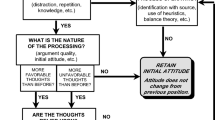Abstract
To ascertain whether actual and perceived emotional sending are distinct constructs, the present study investigated the relationship between subjects' ability to facially express six basic emotions and their perceived success at expressing these emotions. Sixty-eight subjects completed a number of standardized personality scales and were videotaped while attempting to portray six basic emotions. Immediately following the videotaping subjects were asked to rate their perceived success in the emotional-sending task. Observers then judged the emotional-sending videotapes to determine subjects' actual sending abilities. A confirmatory factor analytic model indicated that actual and perceived emotional-sending were distinct factors. Zero-order correlations between the traditional personality measures and the actual and perceived sending factors also supported this distinction. These findings have important implications for the construction of standardized measures of individual differences in nonverbal communication skills.
Similar content being viewed by others
References
Bentler, P. M. & Bonett, D. G. Significance tests and goodness of fit in the analysis of covariance structures.Psychological Bulletin 1980,88 588–606.
Briggs, S. R., Cheek, J. M. & Buss, A. H. An analysis of the Self-Monitoring Scale.Journal of Personality and Social Psychology 1980,38 679–686.
Buck, R., Miller, R. E. & Caul, W. F. Sex, personality, and physiological variables in the communication of emotion via facial expression.Journal of Personality and Social Psychology 1974,30 587–596.
Cunningham, M. R. Personality and the structure of the nonverbal communication of emotion.Journal of Personality 1977,45 564–584.
Ekman, P. & Friesen, W.Unmasking the face. Englewood Cliffs, NJ: Prentice-Hall, 1975.
Eysenck, H. & Eysenck, S.Manual for the Eysenck Personality Inventory. San Diego: Educational and Industrial Testing Service, 1968.
Friedman, H. S. The concept of skill in nonverbal communication: Implications for understanding social interaction. In R. Rosenthal (Ed.),Skill in nonverbal communication. Cambridge, MA: Oelgeschlager, Gunn & Hain, 1979.
Friedman, H. S., Prince, L. M., Riggio, R. E. & DiMatteo, M. R. Understanding and assessing nonverbal expressiveness: The Affective Communication Test.Journal of Personality and Social Psychology 1980,39 333–351.
Friedman, H. S. & Riggio, R. E. Effect of individual differences in nonverbal expressiveness on transmission of emotion.Journal of Nonverbal Behavior 1981,6 96–104.
Friedman, H. S., Riggio, R. E. & Segall, D. O. Personality and the enactment of emotion.Journal of Nonverbal Behavior 1980,5 35–48.
Gabrenya, W. K. & Arkin, R. M. Self-Monitoring Scale: Factor structure and correlates.Personality and Social Psychology Bulletin 1980,6 13–21.
Gorsuch, R. L.Factor analysis. Philadelphia: Saunders, 1974.
Hall, J. A. Gender, gender roles, and nonverbal communication skills. In R. Rosenthal (Ed.),Skill in nonverbal communication. Cambridge, MA: Oelgeschlager, Gunn & Hain, 1979.
Harper, R. G., Wiens, A. N. & Matarazzo, J. D.Nonverbal communication: The state of the art. New York: John Wiley & Sons, 1978.
Jackson, D. N.Personality Research Form manual. New York: Research Psychologists Press, 1974.
Joreskog, K. G. A general approach to confirmatory maximum likelihood factor analysis.Psychometrika 1969,34 183–202.
Joreskog, K. G. & Sorbom, D.LISREL IV: Analysis of linear structural relations by the method of maximum likelihood. Chicago: National Educational Resources, Inc., 1978.
LaFrance, M. & Mayo, C.Moving bodies: Nonverbal communication in social relationships. Monterey, CA: Brooks/Cole, 1978.
Riggio, R. E. & Friedman, H. S. The interrelationships of self-monitoring factors, personality traits, and nonverbal social skills.Journal of Nonverbal Behavior 1982,7 33–45.
Rosenthal, R. (Ed.).Skill in nonverbal communication. Cambridge, MA: Oelgeschlager, Gunn & Hain, 1979.
Rosenthal, R., Hall, J. A., DiMatteo, M. R., Rogers, P. L. & Archer, D.Sensitivity to nonverbal communication: The PONS test. Baltimore: Johns Hopkins University Press, 1979.
Snyder, M. The self-monitoring of expressive behavior.Journal of Personality and Social Psychology 1974,30 526–537.
Sorbom, D. Detection of correlated errors in longitudinal data.British Journal of Mathematical and Statistical Psychology 1975,28 138–151.
Zuckerman, M., Hall, J. A., DeFrank, R. & Rosenthal, R. Encoding and decoding of spontaneous and posed facial expressions.Journal of Personality and Social Psychology 1976,34 966–97.
Zuckerman, M. & Larrance, D. Individual differences in perceived encoding and decoding abilities. In R. Rosenthal (Ed.),Skill in nonverbal communication. Cambridge, MA: Oelgeschlager, Gunn & Hain, 1979.
Author information
Authors and Affiliations
Additional information
This research was supported by a UCR intramural research grant and a UCR NIH Biomedical Support Equipment grant. The authors would like to thank Richard Lippa and Louise Prince.
Rights and permissions
About this article
Cite this article
Riggio, R.E., Widaman, K.F. & Friedman, H.S. Actual and perceived emotional sending and personality correlates. J Nonverbal Behav 9, 69–83 (1985). https://doi.org/10.1007/BF00987139
Issue Date:
DOI: https://doi.org/10.1007/BF00987139




